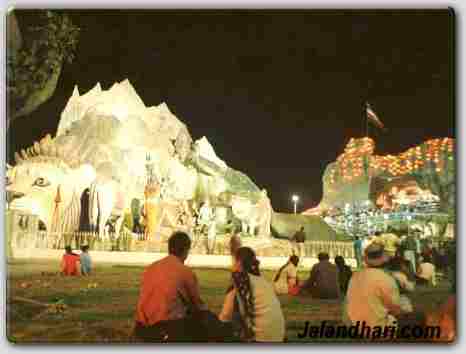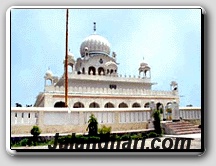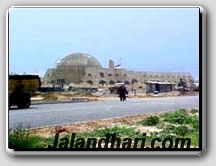Jalandhar Tourism History Here
Jalandhar is believed to have emerged out of the sea. This legendary
origin of Jalandhar is confirmed by some geologists who believe that
once upon a time the sea stretched up to Jalandhar Doab and the
neighbouring Shiwaliks of Hoshiarpur. According to the Padma Purana, the
City takes its name from the great "Daitya" King , Jalandhra, the son of
the Ocean.
The earliest historical mention of Jalandhar occurs in the reign of
Kanishka, when about A.D. 100 a council of Buddhist Theologions met near
Jalandhar chiefly for the purpose of collecting manuscripts and
preparing commentaries on them.
In short following are the places one must visit if he/she is in
Jalandhar. The detailed desciption follows the list.
1. Devi Talab Temple
2. Gurdwara Chhevin Padshahi
3. Imam Nasir Masjid
4.Wonderland Theme Park
4. Shaheed-E-Azam Sardar Bhagat Singh Museum, Khatkar Kalan
5. Pushpa Gujral Science City, one of my favorites
6.St Mary’s Cathedral Church( Jalandhar Cantt)
7. Sheetla Mata Temple
8. Sodal Temple
9. Model Town Gurudwara
10. Tulsi Mandir
11. Shiv Temple
12. Durga Temple, Ajit Nagar.
13. More...
It seems a long list for religious places, but people familiar with
Indian culture understand concept of religion in India is differenr from
concept of religion in western culture. I will not like to get into
political debate but wanted to make a oaint that you should visit these
places irrespective of your religious affliations. These are more of
cultural centres than religious places and huge fairs are held at many
of these places. We welcome pictures or commentary of visitors to these
places and will be happy to share with other users
Jalandhar Brief History:
J
alandhar gave rise to the Nath Movement between the eighth and tenth century A.D. At the site where the samadh of one of the foremost representatives of the movements Jogi Jalandhar Nath once stood, was built the exiting shrine of Imam Nasir-ud-din Chishti in the fifteenth century.Jalandhar was when visited by Hiuen Tsang the capital of a considerable State ruled over by Katoch chiefs, the town itself being more than three kilometers in circuit, It was taken by Ibrahim Sah of Ghor, in A.D., 1179-80 and was a place of considerable importance in the struggle between Jasrath Khokar and the Muhammedan governors in 1422-42.
Under the Mughal Emperors, Jalandhar was always the capital of the northern and most important portion of the Jalandhar Doab which then extended to the neighbourhood of Multan, in fact of the whole of the Doab, as it is now constituted. The last Mohammedan governor was Adina Beg, whose intrigues with the Sikhs and Marathas have already been noticed. Governer Adina Beg died in 1758, having in the previous year allowed Guru Badbhag Singh of Kartarpur, to burn Jalandhar in revenge for the destruction of Katarpur by Ahmad Shah Abdali in 1756.
In A.D. 1766 Jalandhar fell into the hands of the Sikh Misal of the Faizullapuria, then under Khushal Singh. His son Budh Singh, who succeeded him as head of the Misl, built a masonry fort in the city, the site of which is now occupied by the Killa Mohalla while several of the other leaders built forts of unburnt bricks. In 1811, Diwan Mohkam Chand was sent by Maharaja Ranjit Singh to annex the Faizullapuria possession in the Jalandhar Doab and Sardar Budh singh fled to his protected possession across the Satluj. His troops put some resistance, but gave up in Jalandhar in October. From this time , it was the capital of the possessions of the Lahore State in the Jalandhur Doab until annexation to the British dominions after the First Anglo Sikh War ,1845-46. It then became the headquarters of the Commissionership of the Trans-Satluj States, afterwards known as the Commissionership of Jalandhur.
Jalandhar boasts of many historic monuments. Prominent among them are the mausoleum of Imam Nasir, the fort at Phillaur which once served as Maharaja Ranjit Singh's line of defence against the British, a Shiv Mandir which dates back to the Lodhi era, Devi Talab Mandir, Tombs at Nakodar, Sarai at Nurmahal, Gurudwara at Kartarpur etc.
Devi Talab Mandir
 It is
situated in the heart of Jalandhar City. The old Devi Talab has been
renovated and, in its centre, a new temple has been built. Recently a
model of Amarnath Yatra has been built in the premises.
It is
situated in the heart of Jalandhar City. The old Devi Talab has been
renovated and, in its centre, a new temple has been built. Recently a
model of Amarnath Yatra has been built in the premises. An
old temple of goddess Kali also stands by the side of the Devi Talab.
Harballabh Sangeet Sammelan, Devi Talab A National Musical Fair
held annually during the last week of December at Devi Talab about
11/2km from the railway station. This Sammelan was started by Baba
Harballabh in memory of his Guru Swami Tulja Giri in 1875 and is still
going strong even after 128years. The best of the country's exponents of
instrumental and vocal classical music gather here for the Sammelan.
People from all walks of life look forward to attend this rare gathering
of musicians. Mahatma Gandhi had attended this fair in 1929. It is one
of the premier musical fairs in North India.
An
old temple of goddess Kali also stands by the side of the Devi Talab.
Harballabh Sangeet Sammelan, Devi Talab A National Musical Fair
held annually during the last week of December at Devi Talab about
11/2km from the railway station. This Sammelan was started by Baba
Harballabh in memory of his Guru Swami Tulja Giri in 1875 and is still
going strong even after 128years. The best of the country's exponents of
instrumental and vocal classical music gather here for the Sammelan.
People from all walks of life look forward to attend this rare gathering
of musicians. Mahatma Gandhi had attended this fair in 1929. It is one
of the premier musical fairs in North India.
Wonderland Theme Park is an amusement water park with water games and water rides. The Park spreads over 11 acres with many thrilling rides offering healthy entertainment to all age groups. The park is located about 6 kms from Jalandhar Bus terminus and 8 kms from the Railway Station on Nakodar Road. The water rides includes bumper cars, flying jets, horror house, boating, kiddies' boating, play house, flying dragon and a slide splash. The wave pool is another attraction of the water park. There is an aqua dance floor, where boys and girls enjoy dancing on the tunes of the latest Punjabi hit numbers underneath a canopy that has artificial clouds from where the water comes down like a rainfall. Entrance time is between 9.00am to 10.00pm in dry park and 12.00pm to 8.00pm in water park. Dry Park is open throughout the year. Waterpark is closed in winters as it is not inconvenient to play around in water.
Imam Nasir Masjid
 This
800 year old beautifully designed mausoleum of Imam Nasir is located in
the heart of Jalandhar
This
800 year old beautifully designed mausoleum of Imam Nasir is located in
the heart of JalandharSodal Mandir :
Sodal Temple is situated near Devi Talab temple on Sodal road. The Fair of Baba Sodal is held to memorialize the death anniversary of Sodal, a local child deity. Every year in Anand Chaturdashiof Bhadon i.e in mid-September, a fair is held at the Smadh of Baba Sodal. In side the smadh, there is a painted portrait of Baba Sodal kept decorated with garlands and rosaries. The offering here are distributed among the pilgrims and they sprinkle a few drops on their body.
The legend goes
that
Sodal was born in a family of Chadha clan of Khatri caste in
Jalandhar City. It is said that one day the mother of Baba Sodal went to
nearby pond to wash clothes. Despite her repeatedly asking to him to go
back, he followed her. The mother lost temper and shouted at him, " Have
you come here to die? Go and drown yourself in the pond." It is said
that Sodal asked her three times to repeater words which she did. Sodal
then plunged into the water never to appear again. According to another
version, he simply fell dead on the spot; according to still another
version he transformed himself into a snake and bored himself into the
earth.
The main place of worship is the smadhi of Baba Sodal. Inside the smadhi, there is a painted portrait of Baba Sodal kept decorated with garlands and rosaries and is looked after by a separate priest. There is a pucca tank called ‘Baba Sodal-Da-Sarowar’. The offering at the smadh are distributed among the pilgrims and sprinkle a few drops on their body. Some have a dip in the tank.
Pilgrims of all religions come to the fair from different parts of Punjab, Haryana, Delhi and Uttar Pradesh. Among the pilgrims, females form the majority to seek blessing for children and general well-being of their families
Tulsi Mandir :
An ancient monument in the City is the temple of Vrinda, wife of Jalandhara, in the Kot Kishan Chand locality. It is now also known as Tulsi Mandir. On one side of the temple is a tank which is said to have been the bathing place of the demon Jalandhara. At some distance is the temple of Gupha, with the image of Annapurna, the goddess of plenty, installed in it. Also nearby lies the Brahm Kund and some temples dedicated to Shiva.
Near the Balmiki gate is the Sheetla Mandir, said to
be as old as the City of Jalandhar. Within its premises are also two
small old temples of Hanuman and Shiva.A big fair is held here in month
of August.
Shiv Mandir
Situated at Gur Mandi, Shiv Mandir is reputed to have been built by a Nawab of Sultanpur Lodhi near Masjid Imam Nasar.
Gurdwara Chhevin Patshahi

Shaheed-E-Azam Sardar Bhagat Singh Museum, Khatkar Kalan
A museum at Khatkal Kalan, the native village of the great Martyr Sardar Bhagat Singh, was inaugurated on his 50th death anniversary. It was earlier in Jalandhar district, now became part of Nawanshahr district. To pay homage to the great revolutionary martyrs of the Punjab, who laid down their lives for the liberation of their motherland, all their memorable belongings are displayed here. The half burnt ashes of Sardar Bhagat Singh, Rajguru and Sukhdev including the blood soaked sand and blood stained newspaper in which their ashes were wrapped are preserved and exhibited in the museum. One page of the Lahore Conspirace Case’s Judgement through which martyr Kartar Singh Sarabha was sentenced to death and on which Sardar Bhagat Singh put some notes is also exhibited in the museum. A copy of holy Gita having S. Bhagat Singh’s signatures which was handed over to him in Lahore Jail, and his other personal belongings are displayed here. The painting of the revolutionaries and Gadrites who inspired S. Bhagat Singh to jump into the freedom struggle are also displayed in the museum. A big bronze statue in the memory of the great martyr installed in front of the museum remind us of his great deeds.
A few other places worth mentioning are a Sanyas Ashram (popularly known as Bahrian-da-Talab) on the Kapurthala road. Nathan-Di Bagichi, Darbar Muhammad Jamal Zahra (in Basti Sheikh), Baba Jhandianala (in Basti Nau), shrines of Baba Lakki Shah Pir and Dargah Pir Hazi Shah Qutab situated in the Jalandhar Cantonment.
Outside the Nakodar town, there are two fine Muhammedan tombs situated close together. These are maintained as protected monuments by the Archaeological Departments. One of these tombs was built in A.D.1612 in the beginning of the reign of Jahangir(A..D.1605-1627 A.D.) and the other in 1657 A.D towards the close of the reign of Shah Jahan (1627-1658 A.D.)
The Gurudwara at Kartarpur (16 km from Jalandhar town) was built by the Fifth Sikh Guru, Guru Arjun Devji in 1656 A.D. Every year, a fair is held on the birth anniversary of the Guru when a large number of devotees gather to pay homage. Kartarpur is also known as the birth place of Swami Virjanand who was the teacher of Swami Dayanand Saraswati, the illustrious founder of the Arya Samaj. A memorial (Guru Virjanand Smarak) has been constructed here in his memory.
St Mary’s Cathedral Church( Jalandhar Cantt)
The old church dedicated to St. Patrick was built by Rev. Fr. John Macodnnel, Q.F.M.CAP of the Vicariate Apostolic of Agra, in 1947 at the same site of new church since 1886. It was looked after by various chaplains appointed to Jalandhar from the Diocese of Lahore. After the partition in 1955, the Catholic Mission of the Indian Punjab was raised to the status of Apostolic p
refect ure
with its headquarter at Jalandhar and the church at Jalandhar Cantonment
became the Cathedral or the Mother Church of Punjab. The demolition of
the old church was started on 15th February, 1987. The foundation stone
for the new church was blessed by His Holiness Pope John Paul II in
February, 1986 and laid by His Excellency Rt. Rev. Dr. Symbhorian
Keeprath Bishop of Jalandhar Diocese on 19th April, 1987. The roofing of
the basement, the balcony and the main church were done on 19th
September, 19th November and 19th December, 1987 respectively. The
church was designed in such a way as to highlight the secular character
of our motherland. Te new church was blessed by His grace Archbishop
Jose Sanchez, the special delegate of Pope John Paul II from Rome and
inaugurated by His Grace Archbishop Agostino Cacciavillan, the Vatican
Ambassador and the Apostolic pronounced to India on 29th October, 1989,
the day of the National Festival of Light, Diwali. On this occasion
Archbishops and Bishops representing different regions of India were
also present.
ure
with its headquarter at Jalandhar and the church at Jalandhar Cantonment
became the Cathedral or the Mother Church of Punjab. The demolition of
the old church was started on 15th February, 1987. The foundation stone
for the new church was blessed by His Holiness Pope John Paul II in
February, 1986 and laid by His Excellency Rt. Rev. Dr. Symbhorian
Keeprath Bishop of Jalandhar Diocese on 19th April, 1987. The roofing of
the basement, the balcony and the main church were done on 19th
September, 19th November and 19th December, 1987 respectively. The
church was designed in such a way as to highlight the secular character
of our motherland. Te new church was blessed by His grace Archbishop
Jose Sanchez, the special delegate of Pope John Paul II from Rome and
inaugurated by His Grace Archbishop Agostino Cacciavillan, the Vatican
Ambassador and the Apostolic pronounced to India on 29th October, 1989,
the day of the National Festival of Light, Diwali. On this occasion
Archbishops and Bishops representing different regions of India were
also present.
Desh-Bhagat Memorial Hall has been constructed to perpetuate the memory of martyrs who has lost their lives in the fight for freedom from the British rule.Jalandhar has been in the thick of the fight for freedom from the British Raj and has produced many patriots.
Pushpa Gujral Science City


Science City Layout
 S
S
- To create awareness of science in the community
- To develop an interactive learning center through a playful approach.
- To present the marvels of science & technology for public appreciation and understanding.
- To install state of-the-Art gadgets and exhibits to support presentation.
- To supplement Formal Education at grass root level.
- To instill a spirit of Enquiry in the young minds.
The Science City is being developed in 71 Acres of land which has been provided free cost by the State Govt.
Participatory Exhibits of Science WingFor popularization of Science Wing of the Council, a list of initial 20 exhibits mentioned below have been finalized. These have been cleared from the experimental stage and are now being fabricated in the Council. These exhibits would be housed in cabins made of Aluminum Panels
| S.No. | Exhibit’s name | Concept developed |
| 1. | A Big Sphere | Mirror reflection at inclined plane |
| 2. | Look into Infinity | Reflection in parallel mirrors |
| 3. | Illuminate the Tunnel | Reflection in parallel mirrors |
| 4. | Half Me Half You | Reflection & refraction |
| 5. | Slim & Trim | Reflection in concave mirror |
| 6. | Fatty & Bulky | Reflection in convex mirror |
| 7. | Rotate your Face | Reflection in concave mirror |
| 8. | Lattice Structure | FCC, BCC & Simple Cubic structure |
| 9. | Stereo Hearing | Direction of sound & delay in hearing |
| 10. | Mirror Room | Infinite no. of Images in all direction |
| 11. | Image Formula | No. of Images vs. angle between mirrors |
| 12. | Serving Head | Illusion through vanishing body |
| 13. | Blow the Soap Film | Surface Tension & Colours in thin films |
| 14. | Transfer of Momentum | Momentum & Kinetic Energy |
| 15. | Eye-An Aperture | Eye acts as an aperture of a camera |
| 16. | Vanishing Ball | Illusion of creating a ball in space |
| 17. | Touch Hot Filament | Illusion of touching hot filament of a bulb |
| 18. | Primary Colours | Primary colours & Mixture of colours |
| 19. | Water from Where | Creating an unknown source of Water |
| 20. | Playing Carom | Ellipse has two foci |

